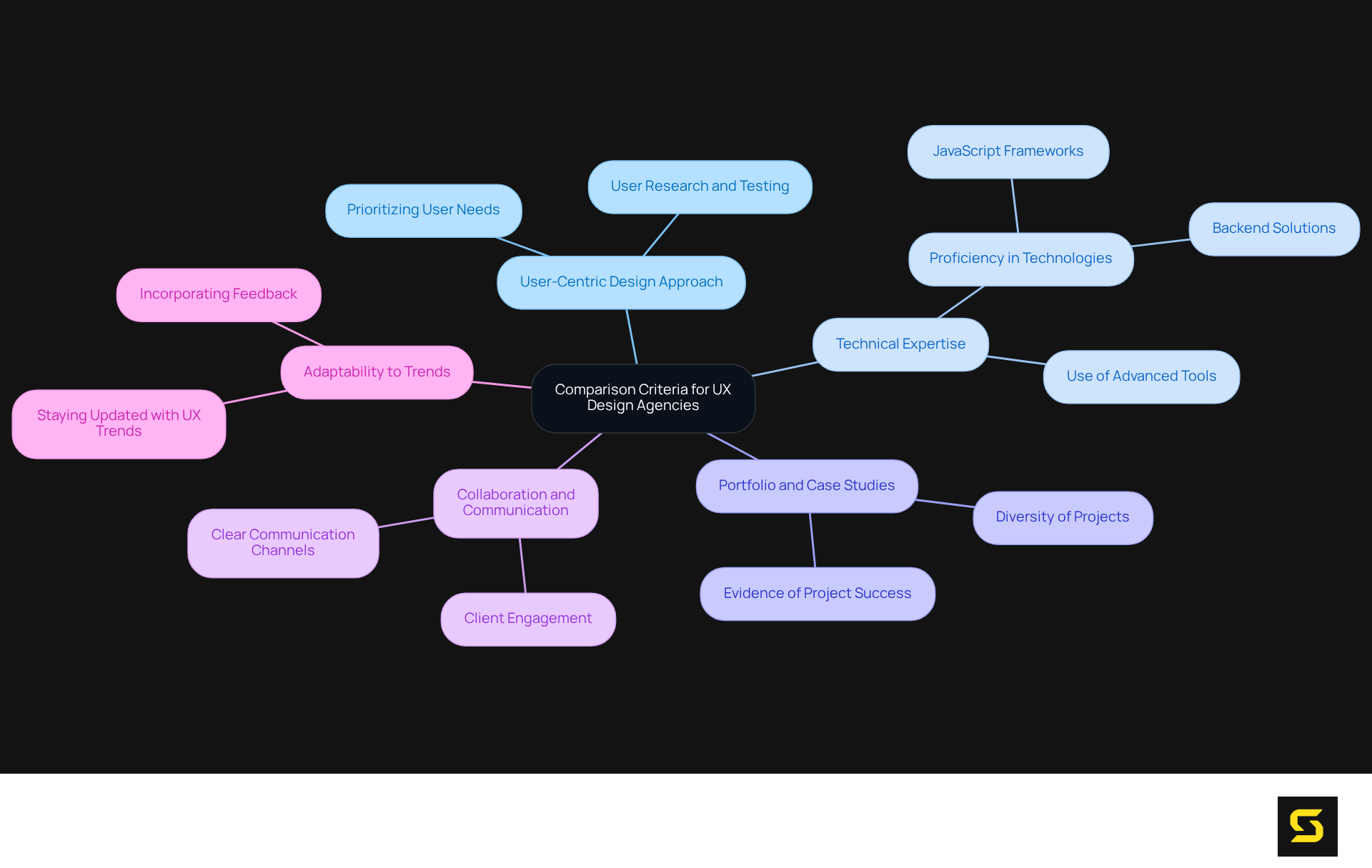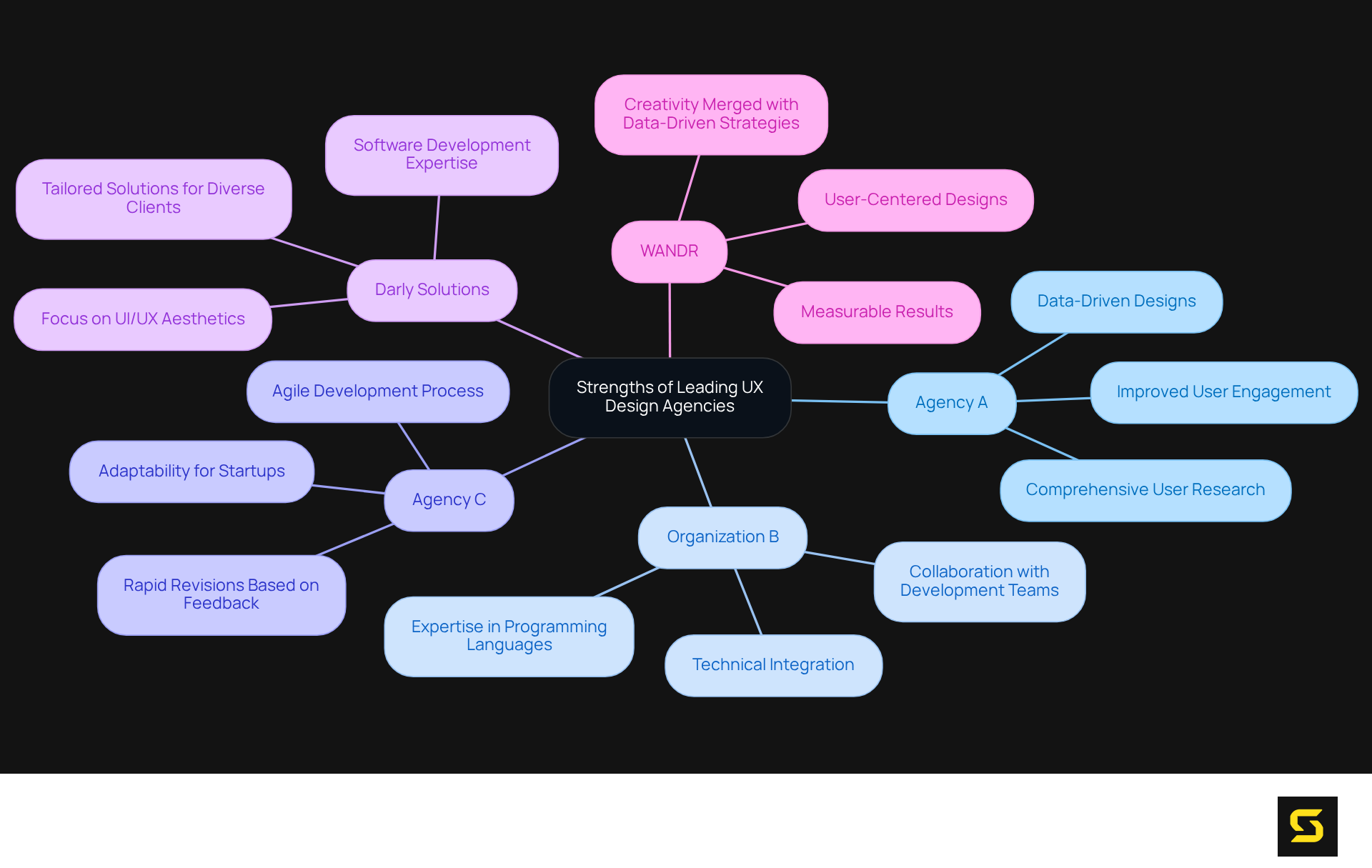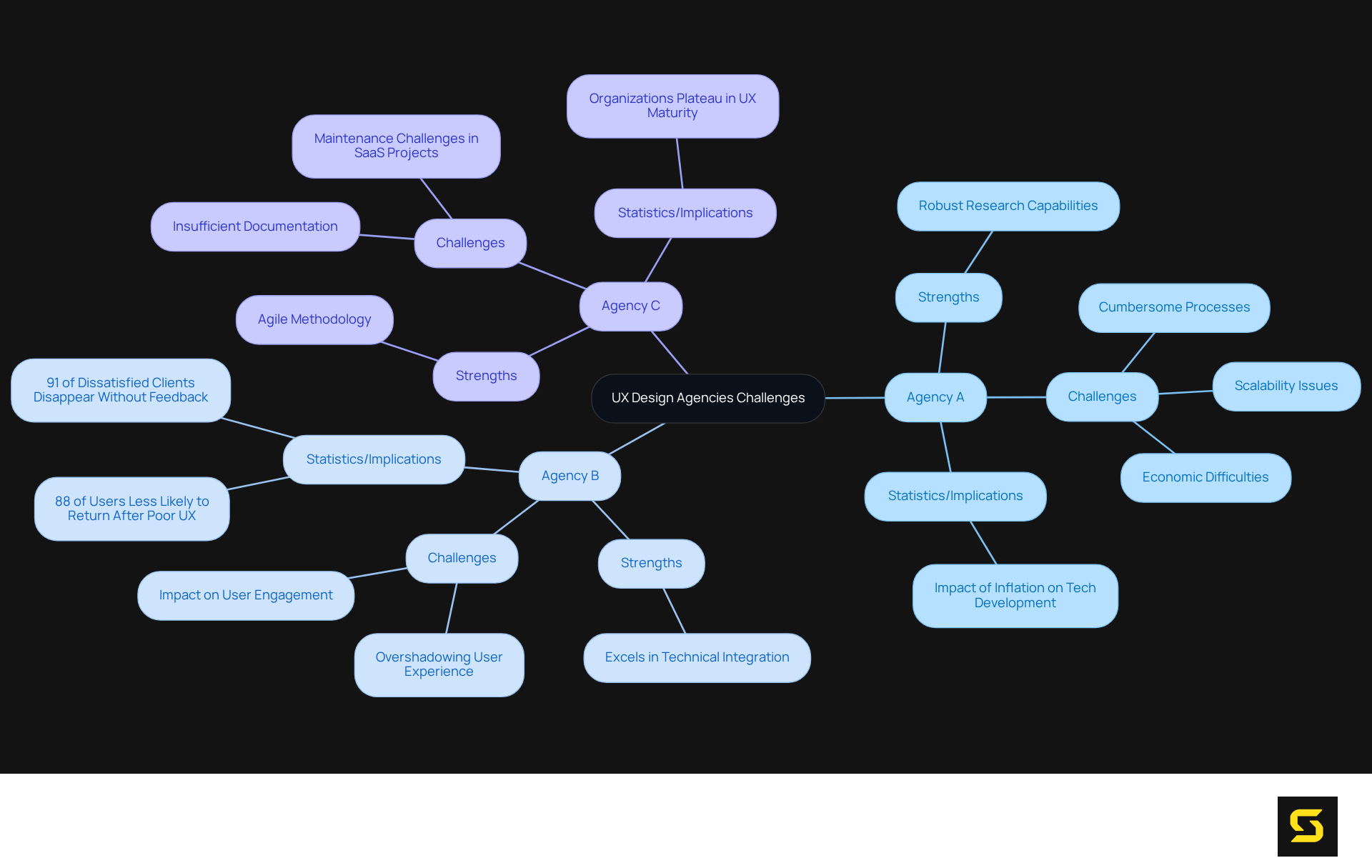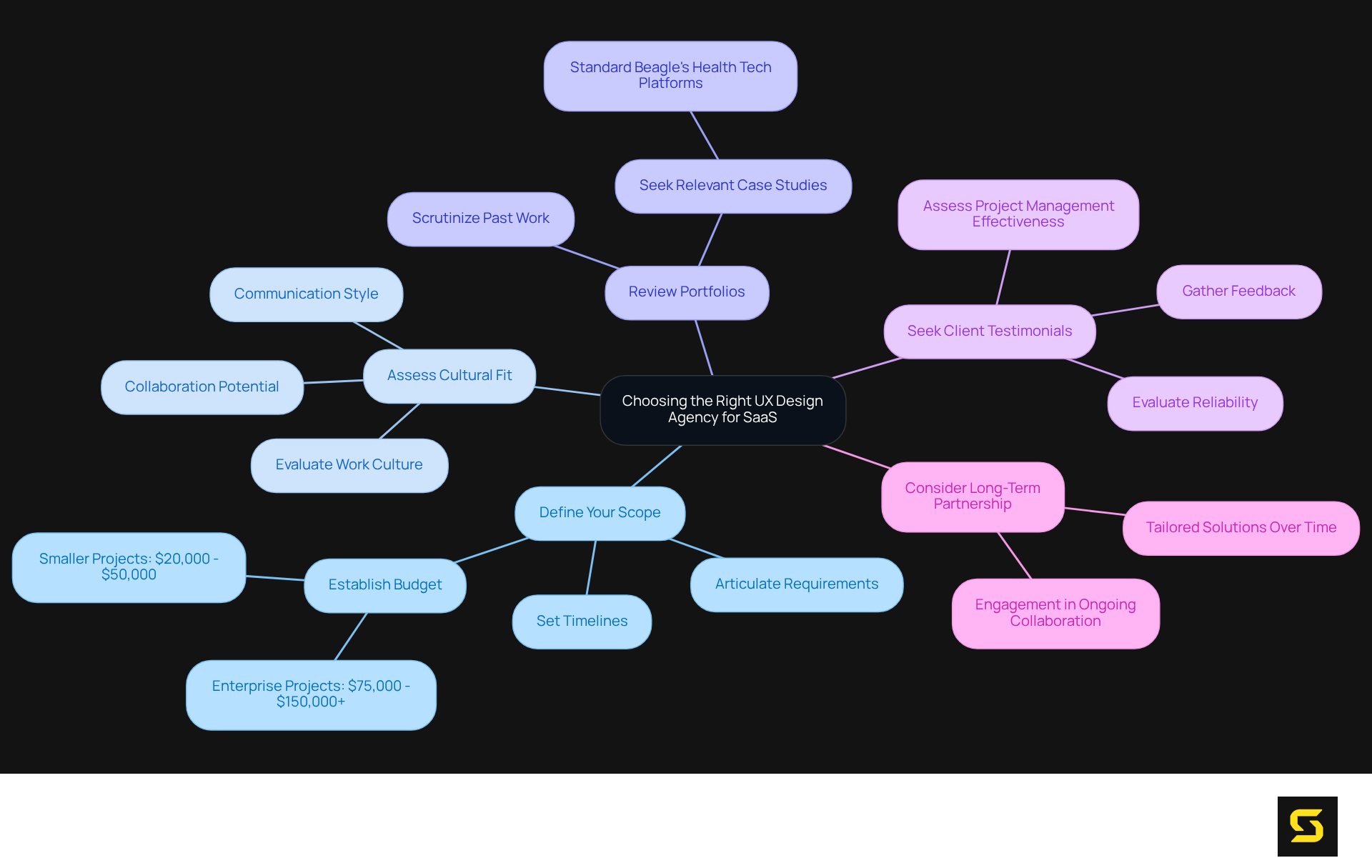Overview
This article presents a thorough evaluation of UX design agencies specializing in SaaS, underscoring the critical strengths and challenges these agencies face. It establishes a robust framework for assessment, concentrating on vital criteria such as:
- User-centric design
- Technical expertise
- Adaptability
Furthermore, it addresses potential limitations that may impact project outcomes. By doing so, it effectively guides organizations in selecting the most appropriate agency tailored to their specific needs.
Introduction
In the intricate realm of SaaS development, the influence of UX design agencies is undeniably crucial. These agencies not only craft user experiences but also significantly enhance engagement and retention through their strategic design approaches. This article examines the strengths and challenges faced by various leading UX design agencies, offering a comprehensive framework for assessing their capabilities.
How can organizations effectively choose the right partner from a multitude of options, each presenting its unique advantages and limitations?
Establishing Comparison Criteria for UX Design Agencies
When assessing ux design agencies for SaaS, it is imperative to establish a robust set of evaluation standards that encompass both the technical and strategic dimensions of their services. The following key criteria are essential:
- User-Centric Design Approach: Evaluate the agency's commitment to prioritizing user needs and experiences throughout their design process.
- Technical Expertise: Scrutinize the organization's proficiency in pertinent technologies, including JavaScript frameworks such as React and Angular, as well as backend solutions like PHP.
- Portfolio and Case Studies: Analyze previous projects to gauge the firm's success in delivering effective SaaS solutions.
- Collaboration and Communication: Assess the effectiveness of the organization in collaborating with clients and maintaining clear communication throughout the project lifecycle.
- Adaptability to Trends: Evaluate the organization's ability to stay abreast of UX trends and incorporate them into their designs.
These criteria provide a comprehensive framework for comparing ux design agencies, empowering potential clients to identify the optimal fit for their unique needs and objectives.

Evaluating the Strengths of Leading UX Design Agencies
Leading ux design agencies distinctly enhance their competitive advantage by leveraging specific strengths. For instance:
-
Agency A: Esteemed for its comprehensive user research methodologies, Agency A excels in crafting data-driven designs that significantly boost user engagement. Their unwavering dedication to analytics ensures that every creative choice is rooted in robust evidence, culminating in improved user satisfaction and retention.
-
Organization B: This organization emphasizes technical integration, adeptly collaborating with development teams to ensure the seamless execution of UX concepts. Their expertise in various programming languages allows them to deliver innovative solutions that are both functional and visually appealing, effectively addressing the needs of complex SaaS applications.
-
Agency C: Celebrated for its agile development process, Agency C facilitates rapid revisions based on client feedback. This adaptability positions them as an ideal partner for startups that must pivot swiftly in response to market dynamics.
-
Darly Solutions: Noted for its focus on UI/UX aesthetics and software development, Darly Solutions has successfully completed over 60 projects, showcasing its capability to provide tailored solutions that meet diverse client requirements.
-
WANDR: Recognized as the premier UX agency of 2025, WANDR seamlessly merges creativity with data-driven strategies, ensuring that their designs not only engage users but also yield measurable results.
Grasping the significance of UX design agencies in enterprises is essential, as their effective UX can lead to enhanced engagement, reduced churn, and heightened customer loyalty. The cost spectrum for UX projects typically ranges from $20,000 to $50,000 for smaller tasks, while larger enterprise systems can exceed $75,000 to $150,000. By assessing these strengths, organizations can more effectively identify which agency aligns with their objectives and user needs, ultimately optimizing the efficacy of their digital solutions.

Identifying Challenges and Limitations of Each Agency
While each UX design agency possesses unique strengths, they also face distinct challenges and limitations:
-
Agency A: Although Agency A boasts robust research capabilities, it may encounter scalability issues for larger projects. Their processes can become cumbersome when managing multiple stakeholders, which impedes timely decision-making and task execution. This limitation is especially pronounced in projects requiring extensive collaboration across diverse teams, where a lack of streamlined communication can result in inefficiencies. Furthermore, the economic difficulties and inflation affecting tech development may exacerbate these challenges, complicating Organization A's ability to adapt.
-
Agency B: While Agency B excels in technical integration, their strong focus on technology can sometimes overshadow user experience. This emphasis may produce solutions that are technically proficient yet fail to resonate with users, ultimately impacting user engagement and satisfaction. Studies reveal that 88% of users are less likely to return to a site after a poor UX experience, underscoring the critical need for a balanced approach that prioritizes both functionality and user-centric design. Additionally, 91% of dissatisfied clients who do not voice their concerns simply disappear without providing feedback, highlighting the necessity of addressing user dissatisfaction.
-
Agency C: The agile methodology utilized by Agency C, though beneficial for startups, may result in insufficient documentation. This lack of thorough documentation can pose significant challenges for long-term maintenance and updates, particularly in SaaS projects where ongoing support and iterative improvements are crucial. Without clear records of design decisions and user feedback, teams may struggle to adapt and evolve the product effectively over time. Moreover, organizations often plateau in stages 2 and 3 of UX maturity, which can hinder Agency C's ability to maintain effective documentation and support.
By acknowledging these challenges, organizations can critically evaluate the advantages and disadvantages of each UX design agency, ensuring they select a collaborator that aligns with their needs and risk tolerance.

Recommendations for Choosing the Right UX Design Agency for SaaS
Selecting the ideal UX design agency for your SaaS project necessitates a strategic approach, concentrating on several key factors:
-
Define Your Scope: Clearly articulate your requirements, encompassing timelines, budget, and desired outcomes. This clarity will aid in identifying organizations that cater to your specific needs, ensuring a better fit for your endeavor. Notably, UX initiatives typically range from $20,000 to $50,000 for smaller or early-stage products, underscoring the importance of establishing your budget early on.
-
Assess Cultural Fit: Evaluate the organization's work culture and communication style to guarantee alignment with your team's values and expectations. A robust cultural fit promotes collaboration and enhances project outcomes, as evidenced by successful partnerships where mutual understanding fuels innovation.
-
Review Portfolios: Scrutinize the firm's past work to gauge their design style and effectiveness in delivering user-centric solutions. Seek case studies that illustrate their capacity to tackle challenges akin to yours, such as Standard Beagle's work on health tech platforms, which highlights their expertise in enhancing usability and engagement.
-
Seek Client Testimonials: Gather feedback from previous clients to evaluate the firm's reliability and ability to meet deadlines. Testimonials can provide insights into the firm's project management effectiveness and their commitment to client satisfaction. According to McKinsey, firms that prioritize design outperform their rivals in both revenue and shareholder returns, accentuating the importance of selecting the right firm.
-
Consider Long-Term Partnership: Opt for a firm that is amenable to engaging in a long-term partnership. Ongoing collaboration can yield improved outcomes and a deeper understanding of your business, as organizations that invest in client relationships often deliver more tailored and effective solutions.
By adhering to these recommendations, organizations can make informed decisions when selecting UX design agencies, ultimately contributing to the success of their SaaS initiatives.

Conclusion
Evaluating UX design agencies for SaaS is not merely a task; it is a pivotal undertaking that can significantly influence the success of digital products. By comprehensively understanding the strengths and challenges of various agencies, stakeholders can make informed decisions that align precisely with their specific needs and objectives. The criteria for assessment—user-centric design, technical expertise, collaboration, and adaptability—serve as essential guidelines for identifying the right partner in this dynamic landscape.
This article highlights the distinctive strengths of leading UX design agencies. For instance, Agency A's data-driven methodologies stand out, as does Agency B's prowess in technical integration. However, it also addresses the inherent challenges each agency faces, from scalability issues to the potential neglect of user experience. These insights are vital for organizations seeking to navigate the complexities of UX design, ensuring that they choose a partner capable of delivering effective solutions while mitigating risks.
Ultimately, the selection of a UX design agency demands careful consideration of both the strengths and limitations outlined. By:
- Defining project scopes
- Assessing cultural fit
- Reviewing portfolios
- Seeking long-term partnerships
organizations can significantly enhance their chances of achieving successful outcomes in their SaaS initiatives. Embracing these recommendations will not only streamline the evaluation process but also foster collaborations that lead to innovative and user-friendly digital experiences.
Frequently Asked Questions
What are the key criteria for evaluating UX design agencies for SaaS?
The key criteria include a user-centric design approach, technical expertise, portfolio and case studies, collaboration and communication, and adaptability to trends.
Why is a user-centric design approach important?
A user-centric design approach is important because it ensures that the agency prioritizes user needs and experiences throughout the design process.
What technical expertise should be considered when assessing a UX design agency?
It is essential to scrutinize the agency's proficiency in relevant technologies, including JavaScript frameworks like React and Angular, as well as backend solutions such as PHP.
How can a potential client evaluate an agency's past performance?
Clients can analyze the agency's portfolio and case studies to gauge their success in delivering effective SaaS solutions.
Why is collaboration and communication important in a UX design project?
Effective collaboration and communication are crucial for maintaining clarity and alignment between the agency and the client throughout the project lifecycle.
How does adaptability to trends impact a UX design agency's effectiveness?
An agency's ability to stay abreast of UX trends and incorporate them into their designs is important for ensuring that their solutions remain relevant and effective.





